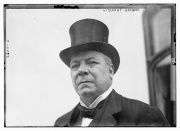Background↑
Born into a Liberal-minded and professional family, Richard Burdon Haldane (1856-1928) attended Edinburgh Academy, studied philosophy at Göttingen and Edinburgh Universities and then read law in London. He won the seat for East Lothian in 1885 for the Liberals and quickly developed a close relationship with others in the Imperialist wing of the party. In 1906, Haldane was appointed Secretary of State for war in a Liberal administration committed to a policy of social welfare. Haldane was convinced that a reduction in army estimates would release money for this purpose. He was also determined to build upon the modest reforms undertaken by Edward Cardwell (1813-1886) and Hugh Oakeley Arnold-Forster (1855-1909). He embarked upon a programme that was to alter the structure and purpose of the Edwardian army fundamentally. Haldane was appointed Lord Chancellor in 1912 but was forced from office in 1915 when accused of pro-German sympathies. His ability to speak German and his interest in German philosophy did not endear him to several of the leading members of the Liberal Party. After the war, Haldane’s loyalty was torn between his Liberal traditions and the social welfare policies of the Labour Party. He was persuaded to join the Labour administration of James Ramsay MacDonald (1866-1937) in 1924.
The Haldane Reforms↑
Haldane succeeded in his aim of substantially reducing army estimates. He aimed to make the small but professional army a strategic and diplomatic lever to further Britain’s improving relations with France. Haldane established the post of chief of the Imperial General Staff and the Army Council and then reorganized the army so that it would be able to send six infantry and one cavalry division to the continent as an expeditionary force. Haldane resisted the public campaign for a form of conscription and instead, against some entrenched opposition from the Rifle Volunteers, but aided by his Director of Military Training and later Director of Staff Duties, Major-General Douglas Haig (1861-1928), created the Territorial Force (TF) of fourteen divisions and fourteen brigades of cavalry. He originally intended this volunteer force to be a vehicle by which the Regular Army could be reinforced or expanded in time of war but political expediency meant that Haldane was forced to compromise and accept that the TF would only be for home defence. Another Haldane creation, the Special Reserve, effectively replaced the militia and was intended as the reinforcement pool for the Regular Army. With a view to future possible expansion, Haldane’s reforms also created the Officer Training Corps, which was based largely in universities, and a Cadet Force which offered adventure and military training for adolescents who, when old enough, were encouraged to join the Regular Army or the TF.
Assessment↑
Haldane’s reform of the Regular Army was considered a major achievement. It is often described as the best equipped and most professional army ever to leave the shores of Britain. Although tiny in comparison to the conscript armies of other Great Powers, its presence on the continent played a significant military, diplomatic and psychological role in halting the German advance on Paris. The Special Reserve was, however, condemned for failing to attract the right quality of men for its short-term service conditions and, with a rapid turnover of personnel, it never secured its intended number of recruits. Similarly, despite a lengthy campaign across the country, Haldane was unable to convince large sections of the public and of the Regular Army of the worth and potential of the TF. Its artillery was thought to be more of a danger to its own side than to any possible enemy and the infantry was often criticised for its inexperience and youth. When Horatio Herbert Kitchener (1850-1916) became Secretary of State for war in August 1914, he ignored the machinery Haldane had put in place to expand the army and opted to create an entirely new force which was free of the constraining terms of service of the TF. Nevertheless, Haldane’s creation provided sufficient men to join what was left of the British Expeditionary Force in order to hold the line through the first winter of the war, to replace Regular Army units in imperial garrison posts and to engage in the battles and campaigns of 1915.
Bill Mitchinson, King's College London
Section Editor: Jenny Macleod
Selected Bibliography
- Beckett, I. F. W.: The amateur military tradition 1558-1945, Manchester 1991: Manchester University Press; St. Martin's Press.
- Bowman, Timothy / Connelly, Mark: The Edwardian army. Recruiting, training, and deploying the British Army 1902-1914, Oxford 2012: Oxford University Press.
- Haldane, Richard Burdon: Richard Burdon Haldane (Viscount Haldane). An autobiography, New York 1929: Doubleday, Doran.
- Mitchinson, K. W.: Defending Albion. Britain's Home Army, 1908-1919, Basingstoke 2005: Palgrave Macmillan.
- Spiers, Edward M.: Haldane. An army reformer, Edinburgh 1980: University Press.








